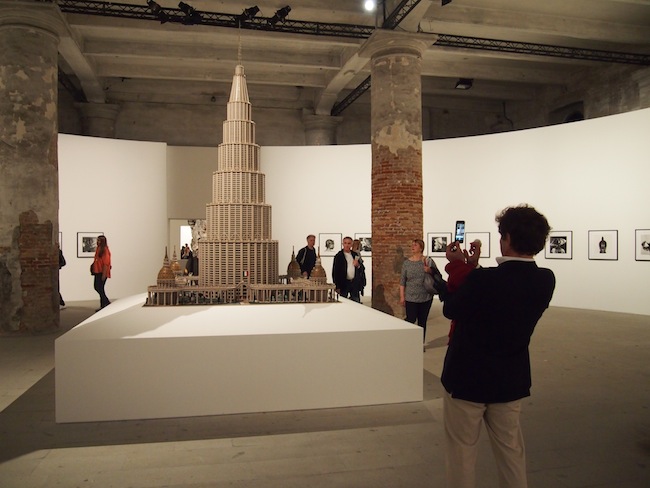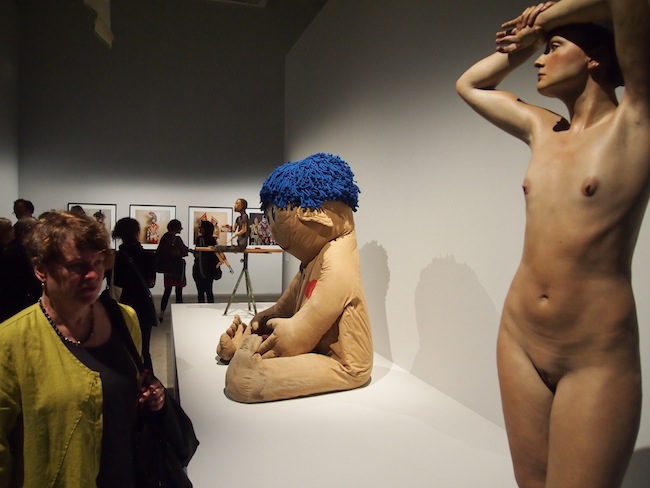
The Body and Materiality in “The Encyclopedic Palace”
31/05/2013
“And what is the point of creating an image of the world when the world itself has become increasingly like an image?”, asks curator Massimiliano Gioni (who is the youngest person ever to have been entrusted with organizing the Biennale's central exhibition) in his introductory essay on the exhibition. What is the role of the artist today, and what makes an artist “an artist”? These are the issues that have been woven into the part of “The Encyclopedic Palace” that is being presented at the Arsenale. (The second part is located in the Giardini, i.e., the Central Pavilion.) The above-mentioned question has given the curator the opportunity to bring together works created by various generations in various times, and by both “real” artists and outsiders/amateurs alike. In addition, none of these divergences from the beaten path of always showing something new – of presenting the future – takes away from the exhibition. Because it is not “the new” that is being spoken about here, but rather, the fundamental. Or, more precisely – how should the art world continue to move forwards more meaningfully, taking into consideration that today, our daily lives are being flooded with visual culture – including things considered to be garbage. Gioni gives back to the artists their status as obsessive dreamers, thereby attempting to pull contemporary art out of the slumber into which it has been placed by the art world system that now chugs along like a well-oiled machine. “The Encyclopedic Palace” at the Arsenale is like a museum – it definitely isn't a “white cube”-type of exhibition, but more like a unified “eclectic microcosm”, as Gioni writes. Over the last few years in Europe and America, there's been a trend of exhibitions being organized like the “cabinets of curiosity” that the well-to-do of the Renaissance-era created for their own enjoyment – arrangements of art works, rare rocks and hunting trophies. The same could be said of “The Encyclopedic Palace”, except this “cabinet” is gigantic. What was the main point of these “cabinets of curiosity”? To show something interesting, exotic and shrouded in myth. One of the pieces in the exhibition is a film of life in Venice's prison for women, made by the Italian Rosella Biscotti (1978). Biscotti tells how practically all of the prisoners that she interviewed said that their only form of escape is the imagination.
“The Encyclopedic Palace of the World”, which inspired the concept for Massimiliano Gioni's exhibition. When American-Italian immigrant Marino Auritis retired from being an auto mechanic in the 1950s, the autodidact began making an architectural model. It soon became an obsession for him, and “The Encyclopedic Palace of the World”, which he patented in 1955, was planned to be a gigantic museum containing all of the world's inventions. Auritis actually looked for funding sources to bring his utopian idea to life, but was unsuccessful. “His dream was timeless”, it says in the annotation, giving proof to our superhuman drive, namely, imagination and creativity.
Curator Joseph Backstein, often called the father of Russian contemporary art
One of the most powerful rooms of the exhibition, filled with human-sized figures in various poses and with natural faces, but with strangely worn-down bodies. Whichever way you turn, there's someone in front of you, but they all have their eyes closed. This is the installation “The Venetians”, by Polish artist Pawel Althamer (1967), made specially fro the Biennale; it is a version of his 2011 work “Almech”.
The Arsenale exhibition transitions from one conceptual zone to the next, and the central part is dedicated to the theme of the body. The body – as man's link to reality, as a bastion that prohibits us from merging with the world of two-dimensional images – is subject to aging and, eventually, collapse. In the forefront is the bronze sculpture “Arial II”, by American artist John DeAndrea (1941), which was created in 2011 and is painted over with oil paints. Next to it, literally spilling its guts, sits Paul McCarthy's (1945) huge, blue-haired doll, “Children's Anatomical Figure”, from 1990.
The extremely realistic sculpture titled “Bus Stop Lady” (1983), by American artist Duane Hanson (1925), is one year older than me, and I've never seen it before in person, but it seems as if I've noticed her numerous times while waiting for a trolley-bus in Riga.
Everyone wants to get their picture taken next to Charles Ray's overly-tall blonde woman, “Fall '91” (1992). It was first displayed in the Los Angeles Museum of Contemporary Art, at the end of a long corridor, and from a distance it looked to be completely normal in size. This contrast between the normal and the abnormal is what creates the piece's magnetic energy.
The second-to-last, dimly-lit room of the Arsenale exhibition has been given over to the works of German artist Dieter Roth (1930-1998), and the American post-minimalist conceptualist, Bruce Nauman (1941). One end of the space is taken up by Roth's “Solo Scenes” (1997/98), an installation made up of 131 TV sets that show scenes from the artist's daily life; it was made shortly before his death. On the opposite wall, on a bigger screen (and on two television monitors), we see an upside-down, spinning head that is nervously humming “mmmm” – from Nauman's 1991 video installation, “Raw Material with Continuous Shift-MMMM”.






